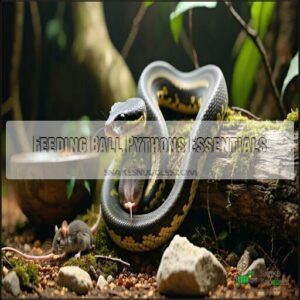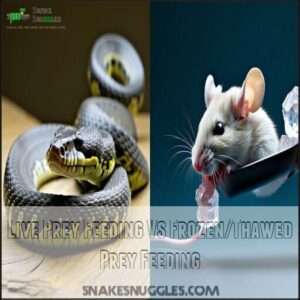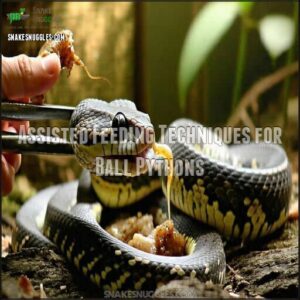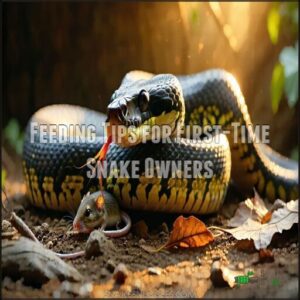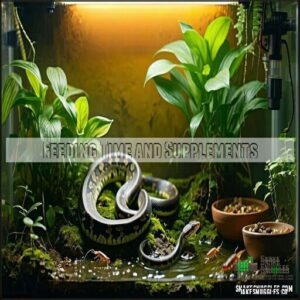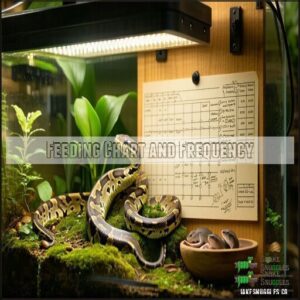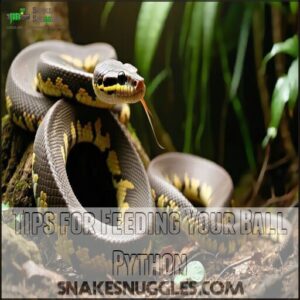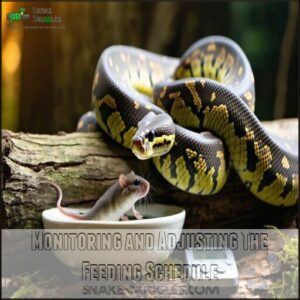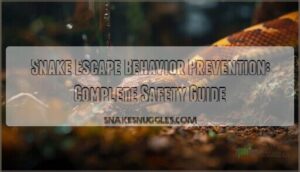This site is supported by our readers. We may earn a commission, at no cost to you, if you purchase through links.

The prey should be about the width of your python’s midsection—think of it as their "goldilocks meal."
Feed juveniles every 5-7 days, sub-adults every 10-14 days, and adults every 2-3 weeks.
You can use frozen/thawed prey to avoid the risks of live feeding.
Offer food during the evening when they’re most active, and don’t handle them for 48-72 hours afterward to avoid regurgitation.
Feeding these shy eaters can feel challenging, but with consistency, they’ll settle into a healthy routine!
Table Of Contents
- Feeding Ball Pythons Essentials
- What to Feed Your Ball Python
- Feeding Schedule Guidelines
- Feeding Techniques for Ball Pythons
- Feeding Time and Supplements
- Common Feeding Troubles and Solutions
- Health and Nutritional Considerations
- Feeding Chart and Frequency
- Tips for Feeding Your Ball Python
- Monitoring and Adjusting The Feeding Schedule
- Frequently Asked Questions (FAQs)
- How much should I feed my ball python?
- Should I feed my ball python at night or during the day?
- Can I hold my ball python 24 hours after feeding?
- Can I feed my snake 2 days in a row?
- Do ball pythons need to be fed?
- How do you feed a ball python?
- When should you feed ball pythons?
- What size prey should a ball python eat?
- Can ball pythons eat soiled food?
- Do ball pythons eat reptilinks?
- Conclusion
Feeding Ball Pythons Essentials
Feeding your ball python properly starts with understanding their dietary needs and the safest feeding methods.
Understanding your ball python’s dietary needs is the first step to keeping them healthy and thriving.
From choosing the right prey size to maintaining a stress-free environment, each detail guarantees your snake stays healthy and eats confidently, which is crucial for their overall well-being and healthy development.
Recommended Prey for Ball Pythons
Providing the right prey is key to your ball python’s diet.
Stick to mice and rats, the gold standard of their dietary needs. Confirm prey matches the snake’s midsection width.
Frozen thawed rodents are safer and simpler than live prey, reducing risks. Ethical prey sourcing guarantees quality and Snake Nutrition.
Following this python feeding guide supports your snake’s health and meets its Dietary Needs consistently.
Suitable Prey Alternatives for Ball Pythons
For a healthier ball python diet, prey variety matters.
Alongside standard rodents, consider alternative foods like chicks, quail, or even young rabbits to diversify their nutrition.
Ethical prey selection is vital—always choose high-quality options to guarantee safety.
By rotating these prey alternatives, you’ll promote better snake nutrition and keep your ball python thriving, making your snake feeding guide more effective!
Prey Size and Type for Ball Pythons
Choosing the right prey is key to your ball python’s health.
Stick with prey no larger than 1.25 times your snake’s midsection width.
This ball python feeding guide guarantees proper prey selection and snake nutrition, maintaining a well-balanced diet.
Understanding proper feeding schedules is vital for the snake’s overall health and growth.
Prey Size Chart for Ball Pythons
Getting the prey size just right guarantees your ball python stays healthy and well-fed.
A proper feeding ratio considers the snake’s girth and growth rates, so keep it simple: prey should match the ball python’s widest midsection.
Here’s a quick prey size chart to help:
- Hatchlings: Start with hopper mice, like small snacks that are easy to handle.
- Juveniles: Graduating to fuzzy rats aligns better with their growing nutrition needs.
- Sub-Adults: Rat pups offer the perfect blend of size and substance.
- Adults: Medium rats are ideal—nothing too big to overwhelm digestion.
Prey measurement matters.
Tracking a snake feeding schedule guarantees their nutrition matches every stage.
What to Feed Your Ball Python
Feeding your ball python the right prey is essential for its health and growth.
Stick to appropriately sized frozen-thawed mice or rats, as they provide the balanced nutrition your snake needs.
Mice Vs Rats for Ball Pythons
Mice vs. rats sparks debate in prey selection, especially for new snake owners. Hatchlings thrive on mice due to their manageable size, while growing pythons benefit from the nutrition-packed punch of rats.
Switching prey may take patience, so scenting techniques help. Understanding nutritional value comparisons is vital for making informed decisions.
Here’s a quick comparison:
Better feeding choices mean a healthy, happy ball python!
Choosing The Right Prey for Your Ball Python
When handling ball python prey selection, safety and size are key.
Pick prey matching your snake’s mid-body girth. Avoid wild-caught prey—stick to frozen-thawed for safety.
- Stick to size guidelines: No larger than1.25× the snake’s girth.
- Choose frozen options: Safer and parasite-free.
- Inspect quality: Farm-raised rodents guarantee proper snake nutrition.
Simple feeding options, healthier snakes!
Prey Variety for a Well-Rounded Diet
Prey variety is key to a balanced ball python diet.
Rotate prey options to meet dietary needs and enhance feeding variety:
- Mice and Rats: The backbone of meal planning.
- Quail or Chicks: Occasional enrichment options.
- Larger Prey (e.g., Rabbits): Appropriate for adult pythons.
- Ethical Sourcing: Prioritize humane prey selection to support ball python nutrition and overall health.
Feeding Schedule Guidelines
Feeding your ball python on a consistent schedule guarantees proper growth and health at every stage of life.
By adjusting the frequency based on age, size, and activity, you can meet your snake’s unique dietary needs with ease.
Age-Appropriate Feeding Schedule for Ball Pythons
Your ball python’s growth stages dictate its feeding cycles.
Hatchlings eat small meals every 5–7 days to support rapid growth.
Juveniles, in their own energetic phase, require slightly larger prey weekly.
Adults settle into a slower feeding rhythm, enjoying meals every 2–3 weeks.
Tailor the ball python feeding schedule carefully to meet dietary needs and maintain ideal snake nutrition, which is crucial for their overall health and rapid growth.
Frequency of Feedings Based on Age
Feeding your snake requires adapting to its growth stages. Hatchling feedings should occur every 5–7 days, as they’re actively growing.
Juvenile nutrition shifts to every 7–10 days, while adult feeding happens every 10–14 days. Females in breeding cycles may need food every 2–3 weeks, with males adjusting to 3–4 weeks.
Here’s a quick feeding schedule:
- Hatchlings: Every 5–7 days.
- Juveniles: Every 7–10 days.
- Sub-adults: Every 10 days.
- Adults: Every 10–14 days.
- Breeders: Adjust as needed.
Proper prey size selection is essential for the snake’s health.
Factors Influencing Feeding Frequency
A python’s feeding frequency hinges on growth stages, health factors, and environmental impact.
Cooler months or improper conditions often reduce appetite.
Match feeding cycles to the snake’s development, adjusting prey size for nutrient needs.
A consistent snake feeding schedule avoids overfeeding and guarantees proper digestion.
Align feedings with a ball python feeding schedule chart to track frequency effectively and ensure a healthy feeding routine based on the snake’s development.
Adjusting Feeding Schedule for Growth
Your ball python’s growth stages call for changes in its feeding schedule. As it matures, adjust feeding rates and prey size to match its development.
Pay attention to nutrient needs and watch for evolving habits. Use this snake feeding guide to stay on track:
- Monitor weight to confirm proper balance.
- Adjust python feeding size with growth.
- Follow a reliable ball python feeding schedule.
- Track snake feeding frequency regularly.
- Verify size adjustments suit its body.
Feeding Techniques for Ball Pythons
When feeding your ball python, using the proper techniques guarantees a safe and stress-free experience for both you and your pet.
From using tongs to warming frozen-thawed prey, each step plays a critical role in replicating natural feeding behaviors and preventing injuries.
Live Prey Feeding Vs Frozen/Thawed Prey Feeding
In the context of feeding your ball python, you’ve got two main options: live prey or frozen/thawed.
Live prey feeding can engage their hunting instincts but introduces feeding risks, like bites or injuries.
On the other hand, frozen/thawed prey stands out for prey safety and convenience.
The use of frozen prey items can be beneficial for snake owners.
Here’s why frozen/thawed prey might be your go-to choice:
- Safety First: No risk of your snake getting hurt.
- Cost-Friendly: Buy in bulk and save long-term.
- Stress-Free Feeding: Keeps your snake calm during meals.
Assisted Feeding Techniques for Ball Pythons
Struggling with a reluctant eater? Assisted feeding can help! Warm prey to about 100°F, or try dipping it in chicken broth for added scent appeal.
Use feeding aids like Snake Tongs to present the prey gently, nudging if needed. Prey presentation matters—position it near the snake’s mouth.
If all else fails, tube feeding may be required under professional guidance. Be patient; persistence and the right feeding techniques resolve most ball python feeding issues.
Feeding Tips for First-Time Snake Owners
Ready to start? Handling your first feeding is easy when you stick to the basics. Always use pre-killed rodents for safety and pick prey no wider than your python’s girth.
Feeding tongs keep fingers safe while presenting prey.
- Gently warm the rodent to 100–105°F.
- Offer prey in the evening for natural hunting behavior.
- Never feed live animals.
- Avoid handling for 72 hours post-meal to ensure your python digests its food properly and to prevent regurgitation.
Feeding Time and Supplements
You’ll need to establish a consistent feeding schedule that aligns with your ball python’s natural hunting hours, typically in the evening when these crepuscular creatures are most active.
While high-quality prey generally provides complete nutrition without additional supplements, proper timing and environmental conditions are vital for successful feeding and ideal digestion.
Best Time to Feed Ball Pythons
Your ball python’s digestive system follows natural circadian rhythms that influence when they’re most receptive to food.
Evening hours—between dusk and midnight—offer ideal feeding windows when these nocturnal hunters are naturally alert and active.
Their snake activity peaks during these darker hours, making them more responsive to feeding cues.
Establishing a consistent python feeding schedule that aligns with their biological clock enhances digestion time and reduces feeding stress.
Monitor your snake’s behavior; increased tongue flicking and movement typically signal readiness for their meal, which can help determine the best feeding schedule.
Supplements for Ball Pythons
While ball pythons receive most nutrition from whole prey, strategic supplement use guarantees healthy development for your scaled companion.
- Calcium dusting – Essential when UVB lighting isn’t used, supporting bone development
- Vitamin D3 supplements – Critical for proper calcium absorption and metabolism
- Multivitamin products – Fill nutritional gaps occasionally (every 6 months)
- Calcium-to-phosphorus ratio – Must be balanced for healthy skeletal structure
Replace supplements biannually as vitamin potency naturally degrades.
Dust prey items lightly—overdoing supplements can be as problematic as deficiencies.
Proper ball python care is vital for maintaining a healthy diet and environment.
Vitamin and Mineral Requirements
In contrast to many reptiles, ball pythons rarely need vitamin supplements when fed properly-sized whole prey.
Your snake naturally receives balanced nutrition through consuming entire rodents. However, occasional dusting with calcium or vitamin D3 can prevent nutrient deficiencies, especially without UVB lighting.
Watch for signs of vitamin toxicity if supplementing regularly. Maintaining proper mineral balance is essential, so keep supplementation frequency minimal – typically once monthly for growing pythons, to prevent nutrient deficiencies.
Common Feeding Troubles and Solutions
You’ll encounter feeding challenges with your ball python that can be resolved with proper knowledge and technique.
From regurgitation issues to feeding refusals, understanding these common problems will help you maintain your snake’s ideal health and feeding routine.
Refusal to Eat and How to Stimulate Appetite
When your ball python refuses meals, it’s time for some feeding detective work. Food refusal is common but requires attention to prevent health issues.
Combat appetite loss in reluctant eaters with these stress reduction techniques:
- Lower handling frequency during feeding attempts
- Try prey switching from mice to rats (or vice versa)
- Make enclosure enrichment adjustments for security
- Check temperatures—proper heat is essential for digestion
Illness detection is vital if refusal persists. Watch for respiratory symptoms, weight loss, or unusual behavior.
For stubborn cases, try warming prey items, braining (exposing brain tissue), or using feeding tongs to mimic movement. Remember, handling adjustments post-feeding are essential—leave your snake undisturbed for 48 hours.
Regurgitation and How to Prevent It
You’ve helped your ball python overcome food refusal, but regurgitation presents another challenge.
This concerning issue typically results from stress, improper temperature regulation, or handling too soon after feeding.
Ensure proper digestion time by avoiding disturbances after meals, and consider the importance of a calm environment to prevent issues like defensive posture and lethargy.
Overfeeding and How to Avoid It
Overfeeding your ball python can lead to serious health issues, much like a car with too much fuel will eventually break down.
Watch for obesity signs – visible skin between scales, fatty deposits, and sluggish movement.
- Monitor weight regularly to maintain healthy body condition
- Follow age-appropriate feeding charts to control portions
- Reduce feeding frequency rather than offering smaller prey
Never power feed for accelerated growth – it’s dangerous and shortens lifespan.
Health and Nutritional Considerations
You’ll need to monitor your ball python’s weight and overall body condition regularly to guarantee proper nutrition and prevent health complications.
A well-balanced feeding schedule that matches your snake’s age, size, and individual needs forms the foundation of long-term health and vitality.
Signs of Malnutrition in Ball Pythons
Recognizing malnutrition early safeguards your snake health.
Watch for weight loss, reduced muscle mass, and dull skin.
Your ball python weight decreases while the spine becomes visible during starvation .
Poor shedding, decreased activity, and refusal to eat indicate nutritional deficiencies .
The table provides a summary of warning signs, their severity, and the required action.
Monitoring Weight and Body Condition
Regular weight tracking is your window into your ball python’s health.
The body condition score ranges from 1 (emaciated) to 9 (obese), with 5 being ideal. A healthy snake displays a slightly triangular shape without a pronounced spine or loose skin.
- When you monitor weight, you’re safeguarding their future
- Each weigh-in confirms you’re a responsible snake parent
- Consistent tracking prevents health problems before they start and helps you be a more responsible snake parent
Adjusting Feeding Schedule for Health
While monitoring your ball python’s health, adjusting the feeding schedule becomes essential during different growth stages and seasonal changes.
Understanding the vital snake feeding schedule is vital for proper care.
Watch for signs like weight fluctuations, incomplete digestion, or regurgitation that indicate potential health issues.
Your snake’s feeding frequency should adapt to breeding needs, shedding cycles, and environmental changes.
Ball python food requirements vary throughout their lives—increase portions during growth spurts and reduce during winter brumation periods.
Weight management is essential; a healthy snake shows proper muscle tone without obesity.
Always document feeding responses to establish ideal patterns for your specific snake, ensuring proper care and a healthy life.
Feeding Chart and Frequency
You’ll need to adjust your feeding schedule based on your ball python’s age, with younger snakes requiring more frequent meals than adults.
A properly structured feeding chart helps you track growth patterns and guarantees your snake maintains prime health throughout its life stages, which is crucial for a ball python.
Ball Python Feeding Chart by Age and Weight
After monitoring your snake’s health, you’ll need a reliable feeding chart to keep track of their growth.
A ball python feeding chart helps match prey sizes to your snake’s developmental stage. Here’s what works best:
Following this snake feeding guide guarantees proper growth rates and weight management without overfeeding your ball python.
Feeding Frequency for Juvenile, Sub-Adult, and Adult Ball Pythons
Your ball python’s feeding cycles should match its snake development through all life stages.
Follow this precise feeding frequency guide to optimize growth rates and meet dietary needs.
Growth Stage Feeding Frequency Prey Size Weight Range Nutrition Plans
Adjusting Feeding Schedule for Breeding Males and Females
Three distinct feeding cycles emerge for breeding ball pythons due to sex differences in reproductive health.
Breeding Males
Breeding Females
Post-laying Females
You’ll notice breeding females have stronger feeding responses than males. Adjust your snake feeding tips based on individual appetite cues. Proper breeding nutrition fuels successful mating diet cycles.
Tips for Feeding Your Ball Python
You’ll improve your ball python’s feeding experience by implementing these proven techniques based on their natural behaviors and biological needs.
Mastering proper feeding methods guarantees your snake’s prime health and reduces common issues like stress-related feeding refusals or regurgitation.
Feed The Snake in a Different Enclosure
Now that you’ve established your feeding chart, let’s consider where to feed your snake.
Many keepers recommend using a separate feeding enclosure for your ball python. This practice offers several benefits:
- Prevents cage aggression and "food mode" behaviors
- Minimizes substrate ingestion risks
- Creates a distinct feeding routine that reduces stress
This separate space keeps your snake’s home clean while establishing clear feeding boundaries.
Properly designed ball python enclosures can also aid in maintaining a clean and safe environment for feeding.
Do Not Hold The Snake for 72 Hours After Feeding
Now that you’ve moved your python from its feeding enclosure, patience becomes your greatest virtue.
The post-feeding period is critical for your snake’s health.
- Digestion Time: Your ball python needs 48-72 hours of uninterrupted peace to properly digest
- Handling Risk: Premature handling can cause regurgitation, a serious health concern
- Snake Stress: Your python is vulnerable during digestion and handling creates unnecessary anxiety
Wait the full 72 hours—your snake’s digestive system will thank you.
Avoid Overfeeding and Underfeeding
Finding the sweet spot between overfeeding and underfeeding your ball python is essential for health.
Watch for warning signs like skin rolls (overfeeding) or visible spine (underfeeding).
Maintain appropriate Feeding Limits by tracking Weight Management through regular weighing.
Proper Meal Portions prevent Snake Obesity while supporting healthy Growth Rates.
Adjust prey size as your python grows—aim for a meal that creates a gentle bulge without stretching scales excessively.
Monitoring and Adjusting The Feeding Schedule
You’ll need to regularly track your ball python’s weight, shedding cycles, and feeding responses to optimize their diet and prevent health issues.
Maintaining detailed records allows you to make evidence-based adjustments to feeding frequency and prey size as your snake grows from hatchling to adult, which is crucial for their overall health and well-being.
Keeping a Feeding Record for Your Ball Python
While tracking your ball python’s meals might seem tedious, maintaining a feeding log provides valuable insights into your snake’s health and growth patterns.
A thorough feeding record should include:
- Date, prey type/size, and feeding response times
- Weight measurements taken before and after meals
- Notes on behavioral changes or refusal patterns
This systematic meal tracking creates a snake feeding chart that helps identify trends, adjust your feeding schedule appropriately, and guarantee your ball python maintains prime health.
How to Monitor Weight and Body Condition
Monitoring your ball python’s weight and body condition is essential for tracking proper growth and nutrition balance.
Weigh your snake bi-weekly using a digital scale, recording results in your feeding log. Perform regular health checks by examining scales for shine and smoothness.
Assess body shape—healthy pythons should feel firm with a subtle triangular cross-section. Your python’s weight monitoring reveals its overall wellbeing, much like your annual physical tells your health story.
Understanding the proper feeding frequency guidelines is vital for maintaining a healthy weight and body condition in snakes, as outlined in the feeding frequency guidelines.
Adjusting The Fe
Adjusting your ball python’s feeding schedule is like playing a balanced game.
As it grows, monitor weight and tweak the feeding chart. Match python feeding size with its midsection width.
If your snake’s plump, reduce feeding amount; if slim, increase it. Stick to prey variety for nutrition, and use digestion tips to prevent stress from altering ball python food habits.
Frequently Asked Questions (FAQs)
How much should I feed my ball python?
Don’t overthink it: feed prey about as thick as your python’s widest body part.
For adults, offer food every 2-3 weeks; younger snakes need meals weekly.
Trust this simple formula to keep them thriving!
Should I feed my ball python at night or during the day?
Feed your ball python at night to align with its natural hunting instincts.
These snakes are crepuscular, meaning they’re most active during dusk and dawn, so evening feeding encourages a more consistent and natural response.
Can I hold my ball python 24 hours after feeding?
While patience is a virtue, it’s best to give your ball python a full 48 hours after feeding before handling.
Their slow digestion needs peace, so rushing could lead to regurgitation or stress.
Can I feed my snake 2 days in a row?
Feeding your snake two days in a row isn’t recommended.
Snakes need time to digest properly, typically 48-72 hours.
Overfeeding can cause stress or regurgitation, so give your python space and stick to its usual schedule.
Do ball pythons need to be fed?
Think of your ball python like a quiet predator needing nourishment to thrive.
Yes, they need to eat!
Offer appropriately-sized prey based on age and size, usually every 7-14 days, to maintain their health.
How do you feed a ball python?
Hold the warmed, appropriately-sized prey with feeding tongs near your python’s head.
Let it strike and eat at its own pace.
Avoid handling afterward to reduce stress and allow proper digestion.
When should you feed ball pythons?
A ball python can eat every 5-7 days as a hatchling and every 10-14 days as an adult.
Follow their body language—like evening prowling—to know when they’re hungry.
Overfeeding risks obesity, so stay aware.
What size prey should a ball python eat?
Pick a prey size that’s no wider than your snake’s midsection.
Too big risks choking, and too small won’t satisfy hunger.
Aim for 1 to 25 times the diameter of their thickest part.
Can ball pythons eat soiled food?
No, you shouldn’t offer soiled food to a ball python.
Contaminated prey risks bacterial infections or digestive issues.
Always make certain prey is clean, properly thawed, and heated to the right temperature to protect your snake’s health.
Do ball pythons eat reptilinks?
Yes, ball pythons can eat Reptilinks, but they’re not a common choice.
These sausage-like links combine ground prey, offering convenience, but switching snakes to them might require patience since pythons prefer whole-prey like rodents, and shifting them to this food may also need some time.
Conclusion
Imagine your shy ball python finally strikes and eats a perfectly sized frozen mouse—you’ve mastered the basics of their care!
Feeding requires understanding their unique dietary needs and schedule. Stick to the right prey size (matching their midsection), feed at proper intervals for their age, and avoid handling after meals to prevent regurgitation.
Following this snake feeding guide for ball pythons guarantees they stay healthy and thrive. Consistency is key, and your snake will thank you!
- https://www.justanswer.com/pet-reptile/625z6-please-help-i-ball-python-named-esme.html
- https://www.quora.com/How-often-and-how-much-should-one-feed-a-Ball-Python
- https://community.morphmarket.com/t/feeding-schedule-for-current-age-weight/46373
- https://reptifiles.com/ball-python-care-guide/ball-python-feeding/
- https://www.zenhabitats.com/blogs/reptile-care-sheets-resources/ball-python-complete-food-guide?srsltid=AfmBOoqMljjFesKx2nL1Pxi0Ft5PECUaVVKfw3M6zn_334aWbm-Ti2O-

